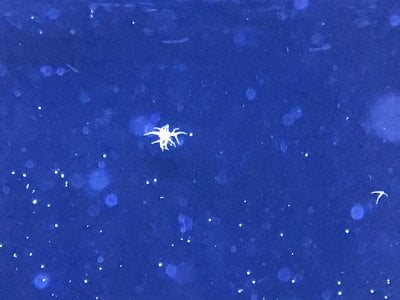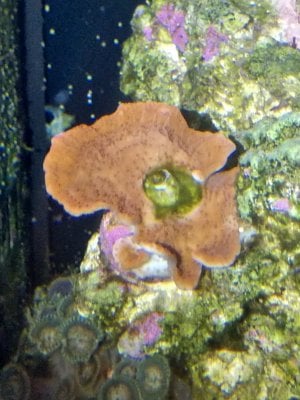Yup that's def a money cowrie, used to collect them in Guam when I was in the service.
Navigation
Install the app
How to install the app on iOS
Follow along with the video below to see how to install our site as a web app on your home screen.
Note: This feature may not be available in some browsers.
More options
You are using an out of date browser. It may not display this or other websites correctly.
You should upgrade or use an alternative browser.
You should upgrade or use an alternative browser.
What is that!! A R2R guide to common new tank hitchhikers.
- Thread starter Crabs McJones
- Start date
- Tagged users None
Crabs McJones
I'm so shi-nay
View Badges

Excellence Award
Reef Tank 365
Article Contributor
Moderator Emeritus
Hospitality Award
Reef Tank 365 Boss
Wisco Reefers
My Tank Thread
Looks like the tentacles of a spionid wormCheers guys. Me again. Noticed a worm type critter coming from the sand. Comes out and squirms around more at feeding. Is this a spaghetti worm or something more ominous?
- Joined
- Oct 15, 2016
- Messages
- 2,024
- Reaction score
- 3,161
I think this is a copepod of some sorts but can’t identify it.



- Joined
- Aug 15, 2017
- Messages
- 4,523
- Reaction score
- 7,484
In your frag tank by chance?I think this is a copepod of some sorts but can’t identify it.


Me too
Munnid isopod according to a guy in my thread in corals forum
- Joined
- Apr 27, 2019
- Messages
- 511
- Reaction score
- 2,239
One of the greatest things about starting a reef tank is getting your live rock in and admiring all the diversity within it. The rock comes to life different creatures. This is a guide that I, along with a very well known critter identifier @KJ , have put together for the new reefer on what these hitchhikers are and whether they're a keeper or to pull them out.
Bristleworm -
Very common good hitchhiker. The jury is out on whether they're beneficial or not. Most consider them a vital part of your clean up crew. The hide within your live rock, coming out to pick up scraps of food and other detritus. Their numbers can become overwhelming based off how much food is available in the tank. If you overfeed, and they have access to an abundance of food, their numbers will increase dramatically. Be careful not to touch as the bristles on the sides of their bodies can be very irritating and cause an allergic reaction in some.
Fireworm -
Bad hitchhiker. Similar to the bristle worm, however if stung by the bristles on this little guy, its 10 times worse. DO NOT TOUCH UNDER ANY CIRCUMSTANCES! If found it is best to remove with a trap.
Pineapple Sponges -
Very common good hitchhiker. These little guys are a type of sponge. They are most commonly found in overflows and in high flow areas of the sump. However, they can sometimes bee seen in shaded areas of your rockwork.
Asterina Starfish -
Another common neutral hitchhiker. Jury is out on these guys as to good or bad. Some people love them, some hate them. They've been rumored to munch on coralline algae. They are also known to multiply very rapidly. Manual removal when seen is best to control their numbers.
Aiptasia -
Bad hitchhiker. This is a type of anemone that multiplies very quickly, and stings and kills anything that gets near it. Depended on how many you have, they're best removed by manually scraping them off the rock, and then using epoxy/superglue/kalk paste over where they were to prevent them coming back. A few predators that you can get for them include the peppermint shrimp, berghia nudibranch, and with a large enough tank, copperband butterflyfish.
Majano -
Bad Hitchhiker. This is another pest anemone that multiplies quickly and stings anything near it. Best removed by manual scraping off and super glue/epoxy/kalk past over its spot. Peppermint shrimp will reportedly consume them as well.
Vermedit Snail -
Very common neutral hitchhiker. They are generally harmless, but can multiply quickly based off nutrients in the tank, and can irritate corals. Manual removal or starving them out by putting a dab of superglue on the end of the tube is best to keep their numbers in check, as well as nutrient control.
Spirorbid Worm -
Very common neutral hitchhiker. These guys are most commonly found in overflows, and high flow areas of your sump. Can multiply very quickly and have been rumored to disrupt equipment such as pumps. Nutrient control keeps their numbers in check.
Ball Anemone -
Common neutral hitchhiker. They are found in shaded areas of live rock, and tend to not bother anything and numbers are kept in check with nutrient control. Are removed by the same means as the aiptasia and majano.
Stomatella Snail -
Very good hitchhiker. These guys are a great clean up crew member. They can be very elusive and most commonly found after lights out and are very fast moving. They feed off different algae in the tank.
Copepod/Isopod/Amphipod -



Very good hitchhikers. Often referred to as simply "pods" These little guys live within your rock work and make great food for your fish and corals. They can be the primary diet of certain mandarins.
Spaghetti Worm -
Good hitchhiker. Commonly found in the sand bed or live rock. They extend out multiple tentacles to catch floating detritus. Good member of your clean up crew.
Hydroids -

Bad hitchhikers. Good news is that they don't tend to live very long and die off on their own as the tank progresses.
Sponges -
Good hitchhiker. Very common filter feeders. Found in shaded areas of live rock
Serpent And Brittle Starfish -

Good hitchhikers. Are most commonly found by the arms extending out from cracks and holes in rock work. Feed off leftover food and detritus in the tank.
Bobbit Worm -
Very bad hitchhiker. These guys can grow to be very large and can kill fish. Most common means of removal is to remove the entire rock where the worm is housed. Be careful of the pincer teeth at the head of the worm.
Tunicate -
Good hitchhiker. Harmless filter feeder. At first glance looks like a sponge, except it pulses as it takes in and expels water, and reacts to touching it.
Limpet -
Good hitchhiker. Consumes algae. Don't seem to bother anything.
Chiton -
Good hitchhiker. Consumes algae. Does not appear to bother anything.
Peanut Worm -
Good hitchhiker. Lives in live rock and feeds off of extra food and detritus.
Gorilla Crab -
Bad hitchhiker. Can be found in live rock cracks, caves and holes. They are predatory and will hunt your shrimp and inverts. They can also grow rather large.
I did not cover Nudibranch, Snails, or Flatworms in this thread as there are far to many variations to cover. If you have an unknown, please create a thread or post it in this thread and we'll try our best to ID it for you. If you have any additions to the list please PM me and I'll review it and add to the list. Very good read, thank you. You’ve pretty much covered everything that’s typically found on the rock
- Joined
- Oct 15, 2016
- Messages
- 2,024
- Reaction score
- 3,161
Yes my Frag tank only.
I recently hooked a new frag tank in line with my 90G Display (sharing the same sump. I can't find any of these in the 90 but I do have clowns and a blue hippo, perhaps eating them.
I just bought a 6 line wrasse for the Frag tank but for the last 4 weeks, nothing but corals. I add Live foods I get from my LFS (I think they get from Reef Nutrition). The population went from none to 1,000 pretty rapidly. My corals all look great, they don't seem to bother anyone. I showed it to my LFS and he's a bit puzzled as well but says this little guy will wipe them out in a short period. Going to be one fat wrasse lol!
I recently hooked a new frag tank in line with my 90G Display (sharing the same sump. I can't find any of these in the 90 but I do have clowns and a blue hippo, perhaps eating them.
I just bought a 6 line wrasse for the Frag tank but for the last 4 weeks, nothing but corals. I add Live foods I get from my LFS (I think they get from Reef Nutrition). The population went from none to 1,000 pretty rapidly. My corals all look great, they don't seem to bother anyone. I showed it to my LFS and he's a bit puzzled as well but says this little guy will wipe them out in a short period. Going to be one fat wrasse lol!
Bat-Slug.Hi what do you call this nudibranch?

BristlewormPloynoid worm?
Just sucked it off my big GSP colony. Been living inside it since I got it, protected from Bauer dip due to how tightly rolled that small section of gsp mat is



Scutus sp. (Elephant Slug )Bat-Slug.
It looks like a big vermetid snail. I glued the opening up
That should kill it.
That should kill it.
Yes.Hi. Is this spaghetti worm? Thank you...
Similar threads
- Replies
- 2
- Views
- 73
- Replies
- 2
- Views
- 162
- Replies
- 13
- Views
- 231
- Replies
- 9
- Views
- 276





















